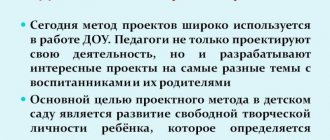Stages of development of ideas about integration in education
Integration entered pedagogy in the early 1980s as a full-fledged scientific concept and as an important category of didactics. Initially, teachers put the same meaning into the concept of integration as other scientists: “Integration - [lat. integratio restoration, replenishment; whole] - the unification of some parts, elements into a whole (the opposite of disintegration." Most studies, one way or another touching on the problem of integration, do not provide an additional definition of this term. The only pedagogical definition of integration that we could find in the works of the 80-90s is belongs to I.D. Zverev and V.N. Maksimova: "Integration is the process and result of creating an inextricably linked, single whole. In education, this is carried out by merging elements of different subjects into a synthesized course (subject, part of the program), merging scientific concepts and methods of different disciplines into general scientific concepts and methods of knowledge, compilation and generalization of the fundamentals of science in the disclosure of interdisciplinary educational problems." This definition arose as a result of the development of ideas about integrative processes in education in recent decades.
The history of integration in Russian education in the 20th century can be considered in a sequence of three stages:
- 1) turn of the century - 20s - workers' school;
- 2) 50-70s - interdisciplinary connections;
- 3) 80s - 90s - integration itself.
Let's look at these stages in more detail.
1. The concept of a workers' school was developed by the famous American philosopher and educator John Dewey. His book School and Society was published in 1899. Integration processes in the economy, politics and social life of people determined the need to organize a new school. The significant impact of intensively developing industry on all aspects of life, including educational thinking. School should stop being a place for memorization. Too much knowledge sometimes leads to loss of individuality. The basis of school education is the activity, work, activity of the child: “We must consider school work on wood and metal, weaving, sewing, cooking as methods of life and learning, and not as separate, independent subjects of study... as tools, with the help of in which the school itself becomes an effective form of active social life, and not a corner divorced from life in which lessons are taught.”
By the beginning of the century, Dewey's ideas gained recognition in Russia. They became especially popular during the period between two bourgeois-democratic revolutions (1907-1917), which contemporaries called the period of pedagogical quest. Russian teachers were impressed by the concept of school as the “embryo of society”, the idea of combining school and life through work, the need to stimulate the child’s contact with the outside world and develop independent critical thinking in children. Immediately after the October Revolution, a lot of organizational and theoretical work began to create a new type of school. The center of Soviet school construction in the first months after the revolution was the State Education Commission, which included N.K. Krupskaya, A.V. Lunacharsky, M.N. Pokrovsky and others. In the summer of 1918, the People's Commissariat of Education and the State Commission worked on the concept of a unified workers' school. The result of the work of the State Education Commission and the People's Commissariat for Education was the “Order on a Unified Workers' School,” published simultaneously with the “Basic Principles of a Unified Workers' School” (“Declaration”).


